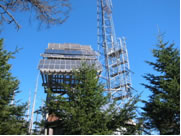Studies
Overview
The National Park Service is involved in many special studies. In contrast to long-term monitoring that provides information on the status and trends of air pollutants, studies are often initiated to answer specific questions about the sources of air pollutants in national parks and the effects of those pollutants on natural resources.

Ecological Assessments are conducted to determine the effects of air pollutants on soils, surface waters, vegetation, and wildlife in national parks. The NPS is particularly concerned about the effects of ozone, nitrogen and sulfur deposition, and toxic contaminants.

Studies are also designed to further our understanding of Ozone Formation & Transport. For several years the NPS has operated enhanced monitoring sites in three Eastern national parks. Passive ozone samplers have also been deployed as a low-cost alternative for determining baseline conditions and spatial distribution of ozone within a park.

Visibility Assessments are conducted in order to determine the causes of visibility impairment at a park or group of parks. These studies involve the collection of ambient air quality, meteorological, and pollutant emissions data.
Other Studies supported by the NPS include the climate change initiative, in-park emission inventories and snowmobile use.
